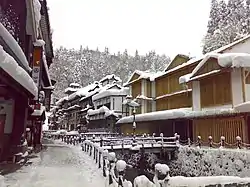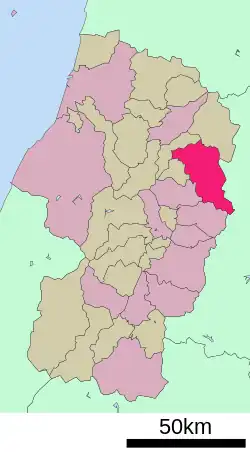Obanazawa
尾花沢市 | |
|---|---|
 Ginzan Onsen in the snow | |
 Flag  Seal | |
 Location of Obanazawa in Yamagata Prefecture | |
 Obanazawa | |
| Coordinates: 38°36′N 140°24′E / 38.600°N 140.400°E | |
| Country | Japan |
| Region | Tōhoku |
| Prefecture | Yamagata |
| Area | |
| • Total | 373.32 km2 (144.14 sq mi) |
| Population (January 2020) | |
| • Total | 15,237 |
| • Density | 41/km2 (110/sq mi) |
| Time zone | UTC+9 (Japan Standard Time) |
| Phone number | 0237-22-1111 |
| Address | 1-1-3 Wakabachō, Obanazawa-shi, Yamagata-ken 999-4292 |
| Climate | Cfa/Dfa |
| Website | Official website |
| Symbols | |
| Flower | Azalea |
| Tree | Japanese Zelkova |

Obanazawa (尾花沢市, Obanazawa-shi) is a city located in Yamagata Prefecture, Japan. As of 1 February 2020, the city had an estimated population of 15,237, and a population density of 40.9 persons per km2. The total area of the city is 372.32 square kilometres (144 sq mi).
Geography
Obanazawa is located in a mountain valley northeast Yamagata Prefecture, bordered by the Mogami River to the west and the Ōu Mountains to the east.
Neighboring municipalities
Climate
Obanazawa has a Humid continental climate (Köppen climate classification Dfa) with large seasonal temperature differences, with warm to hot (and often humid) summers and cold (sometimes severely cold) winters. Precipitation is significant throughout the year, but is heaviest from August to October. The average annual temperature in Obanazawa is 10.8 °C (51.4 °F). The average annual rainfall is 1,538.5 mm (60.57 in) with December as the wettest month. The temperatures are highest on average in August, at around 23.7 °C (74.7 °F), and lowest in January, at around −1.0 °C (30.2 °F).[1] The city is noted for its very heavy snowfall in winter.
| Climate data for Obanazawa (1991−2020 normals, extremes 1976−present) | |||||||||||||
|---|---|---|---|---|---|---|---|---|---|---|---|---|---|
| Month | Jan | Feb | Mar | Apr | May | Jun | Jul | Aug | Sep | Oct | Nov | Dec | Year |
| Record high °C (°F) | 11.9 (53.4) |
14.6 (58.3) |
20.0 (68.0) |
29.0 (84.2) |
33.4 (92.1) |
32.6 (90.7) |
36.2 (97.2) |
35.9 (96.6) |
34.6 (94.3) |
28.2 (82.8) |
23.7 (74.7) |
18.7 (65.7) |
36.2 (97.2) |
| Mean daily maximum °C (°F) | 1.7 (35.1) |
2.7 (36.9) |
6.4 (43.5) |
14.0 (57.2) |
20.4 (68.7) |
23.8 (74.8) |
26.9 (80.4) |
28.4 (83.1) |
24.5 (76.1) |
18.2 (64.8) |
11.0 (51.8) |
4.2 (39.6) |
15.2 (59.3) |
| Daily mean °C (°F) | −1.0 (30.2) |
−0.7 (30.7) |
2.1 (35.8) |
8.2 (46.8) |
14.6 (58.3) |
19.0 (66.2) |
22.5 (72.5) |
23.7 (74.7) |
19.6 (67.3) |
13.1 (55.6) |
6.6 (43.9) |
1.3 (34.3) |
10.8 (51.4) |
| Mean daily minimum °C (°F) | −4.1 (24.6) |
−4.3 (24.3) |
−2.1 (28.2) |
2.8 (37.0) |
9.3 (48.7) |
14.9 (58.8) |
19.1 (66.4) |
19.9 (67.8) |
15.5 (59.9) |
8.5 (47.3) |
2.6 (36.7) |
−1.5 (29.3) |
6.7 (44.1) |
| Record low °C (°F) | −16.3 (2.7) |
−15.5 (4.1) |
−12.3 (9.9) |
−7.6 (18.3) |
−0.9 (30.4) |
5.3 (41.5) |
5.8 (42.4) |
10.2 (50.4) |
3.4 (38.1) |
−1.0 (30.2) |
−7.4 (18.7) |
−17.4 (0.7) |
−17.4 (0.7) |
| Average precipitation mm (inches) | 165.3 (6.51) |
98.4 (3.87) |
80.7 (3.18) |
68.4 (2.69) |
78.4 (3.09) |
105.6 (4.16) |
174.0 (6.85) |
148.9 (5.86) |
128.9 (5.07) |
120.5 (4.74) |
155.2 (6.11) |
197.1 (7.76) |
1,538.5 (60.57) |
| Average snowfall cm (inches) | 322 (127) |
231 (91) |
145 (57) |
17 (6.7) |
0 (0) |
0 (0) |
0 (0) |
0 (0) |
0 (0) |
0 (0) |
18 (7.1) |
216 (85) |
948 (373) |
| Average precipitation days (≥ 1.0 mm) | 23.2 | 19.3 | 16.6 | 11.8 | 10.4 | 10.0 | 12.7 | 11.8 | 12.5 | 13.7 | 17.6 | 22.2 | 181.8 |
| Average snowy days (≥ 3 cm) | 23.6 | 19.7 | 17.3 | 2.8 | 0 | 0 | 0 | 0 | 0 | 0 | 1.8 | 14.5 | 79.7 |
| Mean monthly sunshine hours | 38.0 | 62.0 | 108.3 | 169.4 | 200.0 | 179.0 | 154.6 | 188.5 | 141.7 | 119.5 | 83.6 | 40.8 | 1,485.3 |
| Source: Japan Meteorological Agency[2][1] | |||||||||||||
Demographics
Per Japanese census data,[3] the population of Obanazawa peaked around 1950 and has declined considerably since then.
| Year | Pop. | ±% |
|---|---|---|
| 1920 | 21,517 | — |
| 1930 | 24,320 | +13.0% |
| 1940 | 26,692 | +9.8% |
| 1950 | 33,754 | +26.5% |
| 1960 | 31,538 | −6.6% |
| 1970 | 27,173 | −13.8% |
| 1980 | 25,231 | −7.1% |
| 1990 | 23,909 | −5.2% |
| 2000 | 22,010 | −7.9% |
| 2010 | 18,955 | −13.9% |
| 2020 | 14,971 | −21.0% |
History
The area of present-day Obanazawa was part of ancient Dewa Province. After the start of the Meiji period, the area became part of Kitamurayama District, Yamagata Prefecture. The village of Obanazawa was established on April 1, 1889 with the establishment of the modern municipalities system, and was raised to town status on July 26, 1897. It was made a city on April 10, 1959.
Obanazawa is the origin of one version of the Dontsuki song, the 'Hanagasa Dance Song', a song sung in many parts of Yamagata Prefecture.[4]
Government

Obanazawa has a mayor-council form of government with a directly elected mayor and a unicameral city legislature of 14 members. The city contributes one member to the Yamagata Prefectural Assembly. In terms of national politics, the city is part of Yamagata District 2 of the lower house of the Diet of Japan.
Economy
The economy of Obanazawa is based on agriculture and forestry. In agriculture, Obanazawa is best known for its watermelons.[5]
Education
Obanazawa has four public elementary schools and two public middle schools operated by the city government and one public high school operated by the Yamagata Prefectural Board of Education.
Transportation
Railway
![]() East Japan Railway Company - Ōu Main Line
East Japan Railway Company - Ōu Main Line
- Ashisawa (However, central Obanazawa is also served by Ōishida Station in neighboring Ōishida).
Highway
 Tōhoku-Chūō Expressway – Obanazawa Interchange
Tōhoku-Chūō Expressway – Obanazawa Interchange National Route 13
National Route 13 National Route 347
National Route 347
Local attractions
- Ginzan Onsen
- Nobesawa Ginzan, a National Historic Site
Noted people
- Kotonowaka Terumasa, sumo wrestler
- Norio Sasaki, Japan national women's soccer team head coach
References
- 1 2 気象庁 / 平年値(年・月ごとの値). JMA. Retrieved March 26, 2022.
- ↑ 観測史上1~10位の値(年間を通じての値). JMA. Retrieved March 26, 2022.
- ↑ Obanazawa population statistics
- ↑ "Origins of the Hanagasa Festival / Hanagasa Festival Official 2011". www.hanagasa.jp. Archived from the original on 2012-10-15.
- ↑ "Welcome to Obanazawa !".
External links
 Media related to Obanazawa, Yamagata at Wikimedia Commons
Media related to Obanazawa, Yamagata at Wikimedia Commons- Official Website (in Japanese)